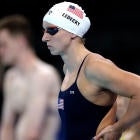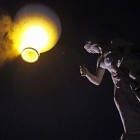The 15th consecutive season of SEC on CBS football kicks off Saturday with No. 6 Auburn taking on Louisville in the annual Chick-Fil-A Kickoff Game, the first of 17 matchups set to be aired by the network this fall as part of an expanded 2015 SEC on CBS slate. Here's everything you need to know about the Tigers' date with the Cardinals.
When: Saturday, Sept. 5, 3:30 p.m. ET | Where: Georgia Dome -- Atlanta, Ga.
On the call: Verne Lundquist (play-by-play), Gary Danielson (color commentary). The 2015 is the 10th consecutive year that Lundquist and Danielson have partnered to call SEC on CBS games.
History: Second meeting; Auburn leads the all-time "series" 1-0, defeating Louisville 16-3 in 1974*.
Line: Auburn -10.5 | O/U: 55.5
At stake: Not many of Louisville's goals would be dashed by an expected Week 1 nonconference loss to a top-10 opponent, which may helpfully let Bobby Petrino's team perform without much in the way of pressure. For an Auburn team picked by the media to win the SEC and chosen by many to claim a College Football Playoff berth, however, an opening-week loss as a double-digit favorite would all-but-eliminate the Tigers' 2015 margin for error before their season even really begins.
Storyline: After Gene Chizik was dismissed in 2012, the coach many Auburn fans wanted to hire (and the coach Auburn reportedly considered) before opting for Gus Malzahn was ... Bobby Petrino, a former Tigers assistant himself who'd been at the center of Auburn's infamous "Jetgate" scandal in 2003. Maybe the Tigers and Cardinals don't have much on-field backstory, but that's not the case for Auburn and Louisville's coach. Can Petrino write another awkward chapter in the two sides' shared history?

Breaking it down
Advantage -- Auburn: throwing the ball on first and second down. The Cards should be fearsome on third-and-long defensively with star end Sheldon Rankins and ballyhooed (for good reason) TCU transfer Devonte Fields capable of getting to the passer against just about anyone. But if Malzahn can catch the Cards front seven thinking rush on early downs, he'll have big-armed quarterback Jeremy Johnson, potential All-SEC target Duke Williams, and the rest of the Tiger wideouts matching up unimpeded against a Louisville secondary that's replacing all four starters from a year ago. Expect big plays to follow.
Advantage -- Louisville: giving Petrino extra time to prepare. Particularly after seeing a whopping 10 players taken in the 2015 NFL Draft, second only to Florida State's 11, Louisville doesn't have any area other than the front seven where they can equal Auburn for raw, on-paper talent. But that doesn't much matter where a Petrino offense is concerned, especially not when he's got multiple quality candidates at quarterback** and faces an Auburn defense that -- for all the ample potential at Will Muschamp's disposal -- has spent years struggling mightily against well-drilled passing attacks. No. 1 receiver James Quick should have an explosive start to his season.
Advantage -- (to be determined): stopping each other's ground game. If no one's going to doubt Auburn's rushing capabilities after Malzahn's first couple of years in charge, it's only fair to extend that same lack of doubt to the Cardinals' front seven. Lorenzo Mauldin's moved on, but linemen Rankins, DeAngelo Brown and Pio Vatuvei are back, along with terrific linebacking tandem James Burgess and Keith Kelsey. That's already the foundation for one of the country's best run-stopping units, and that's before we discuss what Fields might bring to the table. Even for Auburn, rushing straight ahead against the Cards could make for rough sledding.
The downside for Louisville? The sledding might be even rougher on the other side. Auburn's got no shortage of front seven talent of its own in former five-star junior linemen Carl Lawson and Montravius Adams, as well as senior linebackers Cassanova McKinzy and Kris Frost. And unlike a Tigers offensive line that enjoyed plenty of success last season and returns several key pieces, the Cards' O-line struggled badly at times -- finishing 103rd in FBS yards-per-carry -- and returns just 19 career starts. Even a Petrino offense can't win going one-dimensional for 60 minutes, and Auburn might have an even better shot at forcing that one-dimensionality than Louisville does.
One stat to know: Johnson's 78 career attempts don't represent much of a sample size, especially with many of them coming in garbage time or against FCS competition. Still: among all active FBS players with at least 75 attempts, Johnson ranks first in career completion percentage (73.1), yards per attempt (11.0), touchdown percentage (11.5) and QB rating (198.4). Auburn fans aren't giddy over the junior's sky-high ceiling for nothing.
The prediction: Petrino did excellent work in getting the Cards to 9-4 in his first year with the program, but none of those victories came over ranked opposition; Louisville lost by 11 to Florida State and by 23 to Georgia in their only two games against top 25 teams. In Auburn and Malzahn, Petrino's facing an opponent with roughly similar talent to the 'Noles and Dawgs and offensive coaching acumen to rival his own. Though the Cards' ability to slow down Malzahn's running game should keep things close, eventually the Tigers' greater offensive balance and top-to-bottom depth should take its toll. Auburn 35, Louisville 24

* Though Auburn was the home team for that game, the Tigers chose to play the game at Birmingham's Legion Field -- meaning neither of the teams' first two meetings will take place in either Auburn or Louisville.
** Petrino has steadfastly refused to give any indication which of Reggie Bonnafon, Will Gardner, Kyle Bolin or Lamar Jackson will get the start against the Tigers, with all four listed as co-starters on the initial depth chart.















